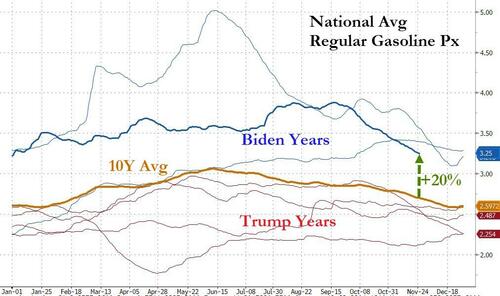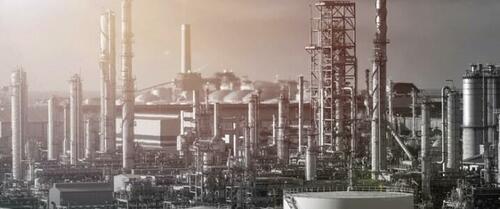
Gasoline prices are on the way down, and we are seeing a lot of chatter from people who are convinced this is political.
After all, we are headed into an election year, and lower gasoline prices certainly help politicians get reelected.
But, neither President Biden (nor his actions) are not why prices are falling, and as the chart below shows, gasoline prices at the pump remain 20% above their 10-year-average for this time of year...
The underlying price of oil is the single largest factor that drives gasoline prices, but there is a seasonal factor behind the changes in gasoline prices.
In fact, as Robert Rapier explains below, via OilPrice.com, gasoline prices fall almost every year between August and November.
As someone whose job it once was to blend gasoline for ConocoPhillips, allow me to explain the reasons.
While many attribute these changes to potential manipulation by vested interests seeking electoral advantages, the actual explanation is two-fold.
Because gasoline evaporates, and given the contribution of gasoline vapors to smog, the Environmental Protection Agency (EPA) strategically regulates gasoline blends seasonally to minimize such emissions.
The EPA achieves this regulation through seasonal limits on something called the Reid vapor pressure (RVP). The RVP specification is temperature-dependent, because evaporation rates increase at higher temperatures. To lower those evaporation rates, the EPA requires lower RVP levels during the summer. While specific RVP limits vary by state, 7.8 pounds per square inch (psi) is a common limit in much of the U.S. during summer.
As September arrives, RVP specifications transition to cold weather blends with RVP limits as high as 15 psi in some locations. This transition significantly impacts gasoline production costs, specifically concerning the inclusion of butane.
Butane, with a high RVP of 52 psi, can be blended into gasoline at higher rates in the fall and winter blends, since the overall vapor pressure can be higher. Butane is cost-effective as it often trades at a $1/gallon discount to crude oil or gasoline. It also increases gasoline supplies by adding a generally abundant component to the gasoline pool.
In the summer, stringent RVP limits make blending significant amounts of butane impractical. However, as limits increase in the fall, the blend can contain more butane, reducing production costs and increasing supply.
The second major factor is that this seasonal shift occurs after the high-demand summer driving season, aligning increased supplies and reduced production costs with falling demand. This confluence almost always leads to a decline in gasoline prices during the fall, benefiting consumers.
There are occasional external factors like hurricanes in the Gulf of Mexico or geopolitical events that can disrupt these seasonal trends. We saw an economic rebound from the pandemic in 2019 that disrupted the normal pattern, and Russia’s invasion of Ukraine in 2022 was one of the factors that helped disrupt the pattern that year.
But this year’s decline is typical of the normal pattern of falling gasoline prices in the fall — regardless of whether it is an election year.
However, this perfect storm comes to an end in spring when RVP specifications are stepped back down in May, increasing costs and reducing supplies in time for the summer driving season.
Gasoline prices are on the way down, and we are seeing a lot of chatter from people who are convinced this is political.
After all, we are headed into an election year, and lower gasoline prices certainly help politicians get reelected.
But, neither President Biden (nor his actions) are not why prices are falling, and as the chart below shows, gasoline prices at the pump remain 20% above their 10-year-average for this time of year…
The underlying price of oil is the single largest factor that drives gasoline prices, but there is a seasonal factor behind the changes in gasoline prices.
In fact, as Robert Rapier explains below, via OilPrice.com, gasoline prices fall almost every year between August and November.
As someone whose job it once was to blend gasoline for ConocoPhillips, allow me to explain the reasons.
While many attribute these changes to potential manipulation by vested interests seeking electoral advantages, the actual explanation is two-fold.
Because gasoline evaporates, and given the contribution of gasoline vapors to smog, the Environmental Protection Agency (EPA) strategically regulates gasoline blends seasonally to minimize such emissions.
The EPA achieves this regulation through seasonal limits on something called the Reid vapor pressure (RVP). The RVP specification is temperature-dependent, because evaporation rates increase at higher temperatures. To lower those evaporation rates, the EPA requires lower RVP levels during the summer. While specific RVP limits vary by state, 7.8 pounds per square inch (psi) is a common limit in much of the U.S. during summer.
As September arrives, RVP specifications transition to cold weather blends with RVP limits as high as 15 psi in some locations. This transition significantly impacts gasoline production costs, specifically concerning the inclusion of butane.
Butane, with a high RVP of 52 psi, can be blended into gasoline at higher rates in the fall and winter blends, since the overall vapor pressure can be higher. Butane is cost-effective as it often trades at a $1/gallon discount to crude oil or gasoline. It also increases gasoline supplies by adding a generally abundant component to the gasoline pool.
In the summer, stringent RVP limits make blending significant amounts of butane impractical. However, as limits increase in the fall, the blend can contain more butane, reducing production costs and increasing supply.
The second major factor is that this seasonal shift occurs after the high-demand summer driving season, aligning increased supplies and reduced production costs with falling demand. This confluence almost always leads to a decline in gasoline prices during the fall, benefiting consumers.
There are occasional external factors like hurricanes in the Gulf of Mexico or geopolitical events that can disrupt these seasonal trends. We saw an economic rebound from the pandemic in 2019 that disrupted the normal pattern, and Russia’s invasion of Ukraine in 2022 was one of the factors that helped disrupt the pattern that year.
But this year’s decline is typical of the normal pattern of falling gasoline prices in the fall — regardless of whether it is an election year.
However, this perfect storm comes to an end in spring when RVP specifications are stepped back down in May, increasing costs and reducing supplies in time for the summer driving season.
Loading…






